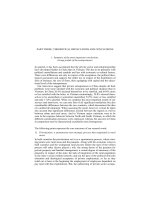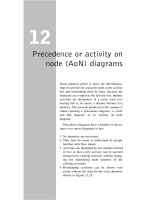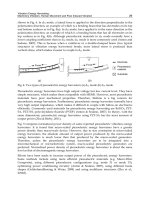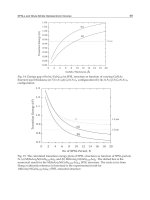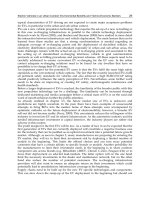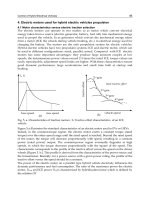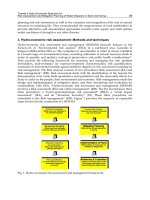Theory of Brain Function quantum mechanics and superstrings - part 3 ppt
Bạn đang xem bản rút gọn của tài liệu. Xem và tải ngay bản đầy đủ của tài liệu tại đây (150.38 KB, 10 trang )
17
While the dynamical process of neural communication suggests that the brain
action looks a lot like a computer action, there are some fundamental differences
having to do with a basic brain property called brain plasticity. The interconnec-
tions between neurons are not fixed, as is the case in a computer-like model, but are
changing all the time. Here I am referring to the synaptic junctions where the com-
munication between different neurons actually takes place. The synaptic junctions
occur at places where there are dendritic spines of suitable form such that contact
with the synaptic knobs can be made. Under certain conditions these dendritic spines
can shrink away and break contact, or they can grow and make new contact, thus
determining the efficacy of the synaptic junction. Actually, it seems that it is through
these dendritic spine changes, in synaptic connections, that long-term memories are
laid down, by providing the means of storing the necessary information. A support-
ing indication of such a conjecture is t he fact that such dendritic spine changes occur
within seconds, which is a lso how lo ng it t akes for permanent memories to be laid
down [12 ].
Furthermore, a very useful set of phenomenological rules has been put forward
by Hebb [2 6], the Hebb rules, concerning the underlying mechanism of brain plasticity.
According to Hebb, a synapse between neuron 1 and neuron 2 would be strengthened
whenever the firing of neuron 1 is followed by the firing of neuron 2, and weakened
whenever it is not. A rather suggestive mechanism that sets the ground for the
emergence of some form of learning! It seems that brain plasticity is not just an
incidental complication, it is a fundamental property of the activity of the brain.
Brain plasticity and its time duration (few seconds) play a critical role, as we will see
later, in the present unified approach to the brain and the mind.
Many mathematical models have been prop osed to try to simulate “learning”,
based upon the close resemblance of the dynamics of neural communication to com-
puters and implementing, one way or ano ther, the essence of the Hebb rules. These
models are known as Neural Networks (NN) [27].
Let us try to construct a neural network model for a set o f N interconnected
neurons. The activity of the neurons is usually parametrized by N functions σ
i
(t), i =
1, 2, . . . , N, and the synaptic strength, representing the synaptic efficacy, by N × N
functions j
i,k
(t). The total stimulus of the network on a given neuron (i) is a ssumed
to be given simply by t he sum of the stimuli coming from each neuron
S
i
(t) =
N
k=1
j
i,k
(t)σ
k
(t) (14)
where we have identified the individual stimuli with the product of the synaptic
strength (j
i,k
) with the activity (σ
k
) of the neuron producing the individual stimulus.
The dynamic equations for the neuron are supposed to be, in the simplest case
dσ
i
dt
= F (σ
i
, S
i
) (15)
with F a non-linear function of its arguments. The dynamic equations controlling
the time evolution of the synaptic strengths j
i,k
(t) are much more involved and only
18
partially understood, and usually it is assumed that the j-dynamics is such that it
produces the synaptic couplings that we need or postulate! The simplest version of a
neural network model is the Ho pfield model [28]. In this model the neuron activities
are conveniently and conventionally taken to be “switch”-like, namely ±1, and the
time t is also an integer-valued quantity. Of course, this all(+1) or none(−1) neural
activity σ
i
is based on the neurophysiology discussed above. If you are disturb ed by
the ±1 choice instead of the usual “binary” one (b
i
= 1 or 0), replace σ
i
by 2b
i
− 1.
The choice ±1 is more nat ura l from a physicist’s point of view corresponding to
a two-state system, like the fundamental elements of the ferromagnet, discussed in
section 2, i.e., the electrons with their spins up (+) or (−).
The increase of time t by one unit corresponds to one step f or the dynamics
of the neuron activities obtainable by applying ( for all i) the rule
σ
i
(t +
i + 1
N
) = sign(S
i
(t + i/N)) (16)
which provides a rather explicit form for (15). If, as suggested by the Hebb rules,
the j matrix is symmetric (j
i,k
= j
k,i
), t he Hopfield dynamics [28] corresponds to a
sequential algorithm for looking for the minimum of the Hamiltonian
H = −
i
S
i
(t)σ
i
(t) = −
N
i,k=1
j
i,k
σ
i
(t)σ
k
(t) (17)
Amazingly enough the Hopfield model, at this stage, is very similar to the dynamics
of a statistical mechanics Ising-type [14], or more generally a spin-glass, model [29]!
This mapping of the Hopfield model to a spin-glass model is highly advantageous be-
cause we have now a justification for using the statistical mechanics language of phase
transitions, like critical points or attractors, etc, to describe neural dynamics and thus
brain dynamics, as was envisaged in section 2. It is remarkable that this simplified
Hopfield model has many attractors, corresponding to many different equilibrium or
ordered states, endemic in spin-glass models, and an unavoidable prerequisite for suc-
cessful storage, in the brain, of many different patterns of activities. In the neural
network framework, it is believed that an internal representation (i.e., a pattern of
neural activities) is associated with each object or category t hat we are capable of
recognizing and remembering. According to neurophysiology, discussed above, it is
also believed that an obj ect is memorized by suitably changing the synaptic strengths.
Associative memory then is produced in this scheme as follows (see corresponding (I)-
(IV) steps in section 2): An external stimulus, suitably involved, produces synaptic
strengths such that a specific learned pattern σ
i
(0) = P
i
is “printed” in such a way
that the neuron activities σ
i
(t) ∼ P
i
(II learning), meaning that the σ
i
will remain
for all times close to P
i
, corresponding to a stable attractor point (III coded brain).
Furthermore, if a replication sig nal is applied, pushing the neurons to σ
i
values par-
tially different from P
i
, the neurons should evolve toward the P
i
. In other words, the
memory is able to retrieve the information on the whole object, from the knowledge
of a part of it, or even in the presence of wrong information (IV recall process). Of
19
course, if the external stimulus is very different from any preexisting σ
i
= P
i
pattern,
it may either create a new pattern, i.e., create a new a tt ractor point, or it may reach
a chaotic, random behavior (I uncoded brain).
Despite the remarkable progress that has been made during the last few years
in understanding brain function using the neural network paradigm, it is fair t o
say that neural networks are r ather artificial and a very long way from providing
a realistic model of brain function. It seems likely that the mechanisms controlling
the changes in synaptic connections are much more complicated and involved than
the ones considered in NN, as utilizing cytosceletal restructuring of the sub-synaptic
regions. Brain plasticity seems to play an essential, central role in the workings of the
brain! Furthermore, the “binding problem”, alluded to in section 2, i.e . , how to bind
together all the neurons firing to different features of the same object or category,
especially when more than one object is perceived during a single conscious perceptual
moment, seems to remain unanswered.
We have come a long way since the times of the “grandmother neuron”, where
a single brain location was invoked for self observation and control, indentified with
the pineal glands by Descartes [30]! Eventually, this localized concept was promoted
to homunculus, a little fellow inside the brain which observes, controls and represents
us! The days of this “Cartesian comedia d’arte” within the brain are gone fo r ever!
It has been long suggested that different groups of neurons, responding to a
common object/category, fire synchronously, implying temporal correlations [31]. If
true, such correlated firing of neurons may help us in resolving the binding problem
[32]. Actually, brain waves recorded from t he scalp, i.e., the EEGs, suggest the exis-
tence of some sort of rhythms, e.g., the “α-rh ythms” of a frequency of 10 Hz. More
recently, oscillations were clearly observed in the visual cortex. Rapid oscillations,
above EEG fr equencies in the range of 35 to 7 5 Hz, called the “γ-oscillations” or the
“40 Hz oscilla tion s”, have been detected in the cat’s visual cortex [33, 34]. Further-
more, it has been shown that these oscillatory responses can become synchronized in a
stimulus-dependent manner! Amazingly enough, studies of auditory-evoked responses
in humans have shown inhibition of the 40 Hz coherence with los s of consciousness
due to the induction of general anesthesia [35]! These remarkable and striking results
have prompted Crick and Koch to suggest that this synchronized firing on, or near,
the beat of a “γ-osc i llation” (in the 35–75 Hz range) might be the neural correlate
of visual awareness [36, 32]. Such a behavior would be, of course, a very special case
of a much more general framework where coherent firing of widely-di s tributed (i.e.,
non-local) groups of neurons, in the “beats” of x-oscillation (of specific frequency
ranges), bind them together in a mental representation, expressing the oneness of
consciousness or unitary sense of self. While this is a remarkable and bold suggestion
[36, 32], it is should be stressed that in a physicist’s language it corresponds to a phe-
nomenological explanation, not providing the underlying physical mechanism, based
on neuron dynamics, that triggers the synchronized neuron firing. On the other hand,
the Crick-Koch proposal [36, 32] is very suggestive and in compliance with the general
framework I developed in the earlier sections, where macroscopic coherent quantum
states play an essential role in awareness, and especially with respect to the “binding
20
problem”. We have, by now, enough motivation from our somehow detailed study of
brain morphology and modeling, to go back to quantum mechanics and develop a bit
further, using string theory, so tha t to be applicable to brain dynamics.
5 Stringy Quantum Mechanics: Density Matrix
Mechanics
Quantum Field Theory (QFT) is the fundamental dynamical framework for a suc-
cessful description of the microworld, from molecules to quarks and leptons and their
interactions. The Standard Model of elementary particle physics, encompassing the
strong and electroweak interactions of quarks and leptons, the most fundamental
point-like constituents of matter presently known, is fully and wholy based on QFT
[37]. Nevertheless, when gravitational interactions are included at the quantum level,
the whole construction collapses! Uncontrollable infinities appear all over the place,
thus rendering the theory inconsistent. This a well-known and grave problem, being
with us for a long, long time now. The resistance of gravitational interactions to
conventionally unify with the other (strong and electroweak) interactions strongly
suggests that we are in for changes both at the Q FT front and at the gravitational
front, so that these two frameworks could become eventually compatible with each
other. As usual in science, puzzles, paradoxes and impasses, that may lead t o major
crises, bring with them the seeds of dramatic and radical changes, if the crisis is looked
upon as an opportunity. In our case at hand, since the Standard Model, ba sed upon
standard QFT, works extremely well, we had not been forced to scrutinize further
the basic principles of the ortho dox, Copenhagen-like QFT. Indeed, the mysterious
“collapse” o f the wavefunction, as discussed in section 3, remained always lacking a
dynamical mechanism responsible for its triggering. Had gravity been incorporated
in this conventional unification scheme, and since it is the last known interaction, any
motivation for changing the ground rules of QFT, so that a dynamical mechanism trig-
gering the “collapse” o f the wavefunction would be provided, would be looked upon
rather suspiciously and unwarranted. Usually, to extremely good approximation, one
can neglect gravitational interaction effects, so that the standard QFT applies. Once
more, usually should not be interpreted as alwa ys. Indeed, for most applications of
QFT in particle physics, one assumes that we live in a fixed, static, smooth spacetime
manifold, e.g., a Lorentz spacetime manifold characterized by a Minkowski metric
(g
µν
denotes the metric tensor):
ds
2
≡ g
µν
dx
µ
dx
ν
= c
2
dt
2
− dx
2
(18)
satisfying Einstein’s special relativity principle. In such a case, standard QFT rules
apply and we get the miraculously successful Standard Model of particle physics.
Unfortunately, this is not the whole story. We don’t live exactly in a fixed, static,
smooth spacetime manifold. Rather, the universe is e xpanding, thus it is not static,
and furthermore unavoidable quantum fluctuations of the metric tensor g
µν
(x) defy the
21
fixed and smooth description of the spacetime manifold, at least at very short distances.
Very short distances here do not refer to the nucleus, or even the proton radius, of
10
−13
cm, but to distances comparable to the Planck length, ℓ
P l
∼ 10
−33
cm, which in
turn is related to t he smallness of G
N
, Newton’s gravitational constant! In particle
physics we find it convenient to work in a system of units where c = ¯h = k
B
= 1, where
c is the speed of light, ¯h is the Planck constant, and k
B
is the Boltzman constant.
Using such a system of units one can write
G
N
≡
1
M
2
P l
≡ ℓ
2
P l
(19)
with M
P l
∼ 10
19
GeV and ℓ
P l
∼ 10
−33
cm.
It should be clear that as we reach very short distances of O(ℓ
P l
), fluctuations
of the metric δg
µν
(x)/g
µν
(x) ∼ (ℓ
P l
/ℓ)
2
∼ O(1), and thus the spacetime manifold is
not well defined anymore, and it may even be that the very notion o f a spacetime
description evaporates a t such Planckian distances! So, it becomes apparent that
if we would like to include quantum gravity as an item in our unification program
checklist, we should prepare ourselves for major revamping o f our conventional ideas
about quantum dynamics and the structure of spacetime.
A particularly interesting, well-motivated, a nd well-studied example of a sin-
gular spacetime background is that of a black hole (BH) [38]. These obj ects are the
source of a singularly strong gravitational field, so that if any other poor objects
(including light) cross their “horizon”, they are trapped and would never come out
of it again. Once in, there is no way out! Consider, for example, a quantum system
consisting of two particles a and b in lose interaction with each other, so that we can
describe its quantum pure state by |Ψ = |a|b. Imagine now, that at some stage
of its evolution the quantum system gets close to a black hole, and that for some
unfortunate reason particle b decides to enter the BH horizon. From then on, we have
no means of knowing or determining the exact quantum state of the b particle, thus
we have to describ e our system not anymore as a pure state |Ψ, but as a mix ed state
ρ =
i
|b
i
|
2
|ab
i
|, according to our discussion in section 3 (see (10,11)). But such
an evolution of a pure state into a m i x ed state is not possible within the conventional
framework of quantum mechanics as represented by (3) o r (9). In conventional QM
purity is eternal. So, something drastic should occur in order to be able to accomodate
such circumstances related to singularly strong gravitational fields. Actually, there is
much more than meets the eye. If we consider that our pure state of the two particles
|Ψ = |a|b is a quantum fluctuation of the vacuum, then we are in more trouble.
The vacuum always creates particle-antiparticle pairs that almost momentarily, and
in the absence of strong gravitational fields, annihilate back to the vacuum, a rather
standard well-understood quantum process. In the presence of a black hole, there is a
very strong gravitational force that may lure away one of the two part icles and “trap”
it inside the BH horizon, leaving the other particle hanging around and looking for
its partner. Eventually it wanders away from the BH and it may even be detected by
an experimentalist at a safe distance from t he BH. Because she does not know or care
about details of the va cuum, she takes it that the BH is decaying by emitting all these
22
particles that she detects. In other words, while classical BH is supposed to be stable,
in the presence of quantum matter, BH do decay, or more correctly radiate, and this
is the famous Hawking radiation [38, 39]. The unfortunate thing is that the Hawking
radiation is thermal, and this means that we have lost va st amounts of inf ormation
dragged into the BH. A BH of mass M
BH
is characterized by a temperature T
BH
, an
entropy S
BH
and a horizon radius R
BH
[38, 39, 40]
T
BH
∼
1
M
BH
; S
BH
∼ M
2
BH
; R
BH
∼ M
BH
(20)
satisfying, of course, the first thermodynamic law, dM
BH
= T
BH
dS
BH
. The origin
of the huge entropy (∼ M
2
BH
) should be clarified. Statistical physics teaches us that
the entropy of a system is a measure of the information unavailable to us about the
detailed structure of the system. The entropy is given by the number of different
possible configurations of the fundamental constituents of the system, resulting al-
ways in the same values for the macroscopic quantities characterizing the system,
e.g., temp erature, pressure, magnetization, etc. Clearly, the fewer the macroscopic
quantities characterizing the system, the larger the entropy and thus the larger the
lack of information about the system. In our BH paradigm, the macroscopic quan-
tities that characterize the BH, according to (20), is only it mass M
BH
. In more
complicated BHs, they may posses some extra “observables” like electric charge or
angular momentum, but still, it is a rather small set of “observables”! This fact is
expressed as the “ No-Hair Theorem” [38], i.e., there are not many different long range
interactions around, like gravity or electromagnetism, and thus we cannot “measure”
safely and f r om a distance other “observables”, beyond the mass (M), angular mo-
mentum (
L), and electric charge (Q). In such a case, it becomes a pparent that we
may have a huge number of different configurations that are all characterized by the
same M, Q,
L, and this the huge entropy (20). Hawking realized immediately that his
BH dynamics and quantum mechanics were not looking eye to eye, and he proposed
in 1982 that we should generalize quantum mechanics to include the pure state t o
mixed state transition, which is equivalent to abandoning the quantum superposition
principle (as expressed in (3) or (9)), for some more advanced quantum dynamics
[41]. In such a case we should virtually abandon the description of quantum states
by wavefunctions or state vectors |Ψ and use the more accomodating density matrix
(ρ) description, a s discussed in section 3, but with a modified form fo r (9). Indeed, in
1983 Ellis, Hagelin, Srednicki, and myself proposed (EHNS in the following) [42] the
following modified fo rm of the conventional Eq. (9)
∂ρ
∂t
= i[ρ, H] + δH/ ρ (21)
which accomodates the pure state→mixed state transition through the extra term
(δH/ )ρ. The existence of such an extra term is characteristic of “open” quantum
systems, and it has been used in the past for practical reasons. What EHNS sug-
gested was more radical. We suggested that the existence of the extra term (δH/ )ρ is
23
not due to practical reasons but to some fundamental, dynamical reasons having to
do with quantum gravity. Universal quantum fluctuations of the g ravitational field
(g
µν
) at Planckian distances (ℓ
P l
∼ 10
−33
cm) create a very dissipative and fluctuat-
ing quantum vacuum, termed spacetime foam, which includes virtual Planckian-size
black holes. Thus, quantum systems never evolve undisturbed, even in the quantum
vacuum, but they are continously interacting with the spacetime foam, that plays
the role of the envi ronment, and which “opens” spontaneously and dynamically any
quantum system. Clearly, the extra term (δH/ )ρ leads to a spontaneous dynamical
decoherence that enables the system to make a transition from a pure to a mixed state
accomodating Hawking’s proposal [41]. Naive approximate calculations indicate that
δH/ ∼ E
2
/M
P l
, where E is the energy of the system, suggesting straight away that
our “low-energy” world (E/M
P l
≤ 10
−16
) of quarks, leptons, photons, etc is, for most
cases, extremely accurately described by the conventional Eq. (9). Of course, in such
cases is not offensive to talk about wavefunctions, quantum parallelism, and the likes.
On the other hand, as o bserved in 1989 by Ellis, Mohanty, and myself [43], if we try
to put together more and more particles, we eventually come to a point where the
decoherence term (δH/ )ρ is substantial and decoherence is almost instantaneous, lead-
ing in other words to a n instantaneous collaps e of the wavefunction for lar ge bodies,
thus making the transition from quantum to classical dynamical and not by decree!
In a way, the Hawking proposal [41], while leading to a major conflict between the
standard QM and gravity, motivated us [42, 43] to rethink about the “collapse” of the
wavefunction, and it seemed to contain the seeds of a dynamical mechanism for the
“collapse” of the wavefunction. Of course, the reason that many people gave a “cold
shoulder” to the Hawking proposal was the fact that his treatment of quantum gravity
was semiclassical, and thus it could be that all the Hawking excitement was noth-
ing else but an artif act of the bad/crude/unjustifiable approximations. Thus, before
we proceed further we need to treat better Quantum Gravity (QG). String Theory
(ST) does just that. It provided the first, and presently only known framework fo r a
consistently quantized theory of gravity [44].
As its name indicates, in string theory one replaces point like particles by one-
dimensional, extended, closed, string like objects, of characteristic length O(ℓ
P l
) ∼
10
−33
cm. In ST one gets an automatic, natural unification of all interactions including
quantum gravity, which has been the holy grail for particle physics/physicists for the
last 70 years! It is thus only natural to address the hot issues o f black hole dynamics
in the ST framework [44]. Indeed, in 1991, together with Ellis and Mavromatos (EMN
in the following) we started a rather elaborate program of BH studies, and eventually,
we succeeded in developing a new dynamical theory o f string black holes [45]. One
first observes that in ST there is an in finity of particles of different masses, including
the Standard Model ones, corresponding to the different excitation modes of the string.
Most of these particles are unobservable at low energies since they a re very massive
M
>
∼
O(M
P l
∼ 10
19
GeV) and thus they cannot be produced in present or future
accelerators, which may reach by the year 2005 about 10
4
GeV. Among the infinity
of different types of particles available, there is an infinity of massive “gauge-boson”-
like particles, generalizations of the W-boson mediating the weak interactions, thus
24
indicating the existence of an infinity of spontaneously broken gauge symmetries, each
one characterized by a specific c harge, g enerically called Q
i
. It should be stressed that,
even if these stringy type, spontaneously broken gauge symmetries do not lead to long-
range forces, thus classically their Q
i
charges are unobservable at long distances, they
do become observable at long distances at the quantum level. Utilizing the quantum
Bohm-Aharonov effect [46], where one “measures” phase shifts proportional to Q
i
, we
are able to “measure” the Q
i
charges from adesirable distance! This kind o f Q
i
charge,
if available on a black hole, is called sometimes and f or obvious reasons, quantum
hair [47]. From the infinity of stringy symmetries, a relevant for us here, specific,
closed subset has been identified, known by the name of W
1+∞
symmetry, with many
interesting properties [48]. Namely, t hese W
1+∞
symmetries cause the mixing [49],
in the presence of singular spacetime backgrounds like a BH, between the massless
string modes, containing the attainable localizable low energy world (quarks, leptons,
photons, etc), let me call if the W
1
-world, and the massive (≥ O(M
P l
)) string modes
of a very characteristic type, the so-called global states. They are called global states
because they have the peculiar and unusual characteristic to have fixed energy E and
momentum p, and thus, by employing the uncertainty type relations, a la (8), they
are extended over all space and time! Clearly, while the global states are as physical
and as real as any other states, still they are una ttainab l e for direct observation to a
local observer. They make themselves noticeable through their indirect effects, while
interacting with, or agitating, the W
1
world. Let me call the global state space, the
W
2
-world.
The second step in the EMN approach [45] was to concentrate on spherically
symmetric 4-D stringy black holes, that can be effectively reduced to 2-D (1 space +
1 time) string black holes of the form discussed by Witten [50]. This effective dimen-
sional reduction turned out t o be very helpful because it enabled us to concentrate
on the real issues of BH dynamics and bypass the technical complications endemic in
higher dimensions. We showed that [45], as we suspected all the time, stringy BH are
endorsed with W - hair, i.e . , they carry an infinity of charges W
i
, correponding to the
W
1+∞
symmetries, characteristic of string theories. Then we showed that [45] this
W -hair was sufficient to establish quantum coherence and avoid loss of information.
Indeed, we showed explicitly that [45] in stringy black holes there is no Hawking radi-
ation, i.e., T
BH
= 0, and no entropy, i.e., S
BH
= 0! In a way, as it should be expected
from a respectable quantum theory of gravity, BH dynamics is not in conflict with
quantum mechanics. There are several intuitive arguments that shed light on the
above, rather drastic results. To start with, the infinity of W -charges make it possi-
ble for the BH to encode any possible piece of information “thrown” at it by making a
transition to an altered suitable configuration, consistent with very powerful selection
rules. It should be clear that if it is needed an infinite number of observable charges
to determine a configuration of the BH, then the “measure” of the unavailable to us
information about this specific configuration should be virtually zero, i.e., S
BH
= 0!
The completeness of the W - charges, and for that matter of our argument, for estab-
lishing that S
BH
= 0, has been shown in two complementary ways. Firstly, we have
shown that [45] if we sum over the W -charges, like being unobservables, we reproduce
25
the whole of Hawking dynamics! Secondly, we have shown that the W
1+∞
symmetry
acts as a phase-space volume (area in 2-D) preserving symmetry, thus entailing the
absence of t he extra W
1+∞
symmetry violating (δH/ )ρ term in (21), thus reestablish-
ing (9), i.e., safe-guarding quantum coherence. Actually, we have further shown that
[45] stringy BHs correspond to “extreme BHs”, i.e., BH with a harmless horizon,
implying that the infinity of W-charges neutralize the extremely strong gravitional
attraction. In such a case, there is no danger of seducing a member of a quantum
system, hovering around the BH horizon, into the BH, thus eliminating the raison
d’etre fo r Hawking radiation! Before though icing the champagne, one may need t o
address a rather fundamental problem. The low-energy, attainable physical world
W
1
, is made of electrons, quarks, photons, and the likes, all very well-known particles
with well-known properties, i.e., mass, electric charge, etc. Nobody, though, has ever
added to the identity card of these particles, lines r epresenting their W-charges. In
other words, the W
1
-world seems to be W-charge blind. How is it possible then for an
electron f alling into a stringy BH, to excite the BH through W
1+∞
-type interactions,
to an altered configuration where it ha s been t aken into account all the information
carried by the electron? Well, here is one of the miraculous mechanisms, endemic in
string theories. As discussed above, it has beeen shown [49] the in the presence of
singular spacetime backgrounds, like the black hole one, a mixing, of purely stringy
nature, is induced between states belonging to different “mass” levels, e.g., between
a Local (L) state (|a
L
) of the W
1
world, with the Global states (G) (|a
i
G
) of the W
2
world
|a = |a
L
+
g
|a
g
G
or
|a
W
= |a
W
1
⊕ |a
W
2
(22)
Notice that any resemblance between the symbols in (22) and (2) is not accidental and
will be clarified later. Thus, we see that when a low energy particle approaches/enters
a stringy BH, its global state or W
2
components while dormant in flat spacetime back-
grounds, get activated and this causes a quantum mechanical coherent BH transition,
always satisfying a powerful set of selection rules. In this new EMN scenario [45]
of BH dynamics, if we start with a pure state |Ψ = |a
W
|b
W
, we end up with a
pure state |Ψ
′
= |a
′
W
|b
′
W
, even if our quantum system encountered a BH in its
evolution, because we can moni tor the |b part through the Bohm-Aharonov-like W
i
charges! So everything looks dandy.
Alas, things get a bit more complicated, before they get simpler. We face here
a new purely stringy phenomenon, that has to do with the global states, that lead
to some dramatic consequences. Because of their delocalized nature in spacetime,
the global or W
2
-states can neither (a ) appear as well - defined asymptotic states, nor
(b) can they be integrated out in a local path-integral formalism, thus defying their
detection in local scattering exp eriments!!! Once more, we have to abandon the
language of the scattering matrix S, for the superscattering matrix S/ = SS
†
, or
equivalently abandon the description of the quantum states by the wavefunction or
state vector |Ψ, for the density matrix ρ [51]. Only this time it is for real. While
26
string theory provides us with consistent and complete quantum dynamics, including
gravitational interactions, it does it in such a way that effectively “opens” our low
energy attainable W
1
world. This is not anymore a possible artifact of our treatment
of quantum gravity, this is the effective quantum mechanics [51, 5, 6] that emerges
from a consistent quantum theory of gravity. An intuitive way to see how it works
is to insert |a
W
as given in (22) into (9), where ρ
W
≡ |a
W
a|
W
, collect all the
|a
W
2
dependent parts, treat them a s noise, and regard (9) as describing effectively
some quantum Brownian motion, i.e. , rega r d it as a stochastic differential equation,
or Langevin equation for ρ
W
1
=
i
p
i
|a
i
W
1
a
i
|
W
1
(see (10)), where the p
i
’s depend
on |a
W
2
and thus on the W
2
world in a stochastic way [52]. In the EMN approach
[51, 52, 5, 6] the emerging equation, that reproduces the EHNS equation (21) with
an explicit form for the (δH/ )ρ term, reads (dropping the W
1
subscripts)
∂ρ
∂t
= i[ρ, H] + iG
ij
[α
i
, ρ]β
j
(23)
where G
ij
denotes some positive de finite “metric” in the string field space, while β
j
is a characteristic function related to the field α
j
and representing collectively the
agitation of the W
2
world on the α
j
dynamics and thus, through (22), one expects
β
j
≈ O((E/M
P l
)
n
), with E a typical energy scale in the W
1
-world system, and
n = 2, 3, . .
Before I get into the physical interpretation and major consequences of (23),
let us collect its most fundamental, system-inde pendent properties, following directly
from its specific structure/form [51, 5, 6]
I) Conservation of p robability P (see (5) and discussion above (9) )
∂P
∂t
=
∂
∂t
(Trρ) = 0 (24)
II) Conservation of energy, on the average
∂
∂t
E ≡
∂
∂t
[Tr(ρE)] = 0 (25)
III) Mon otonic increase in entropy/microscopic arrow of time
∂S
∂t
=
∂
∂t
[−Tr(ρ ln ρ)] = (β
i
G
ij
β
j
)S ≥ 0 (26)
due to the positive definiteness of the metric G
ij
mentioned above, and thus
automatically and n a turally implying a microscopic arrow of time.
Rather remarkable and useful properties indeed.
Let us try to discuss the physical interpretation of (23) and its consequences. In
conventional QM, as represented by (9), one has a determin i s tic, unitary evolution of
